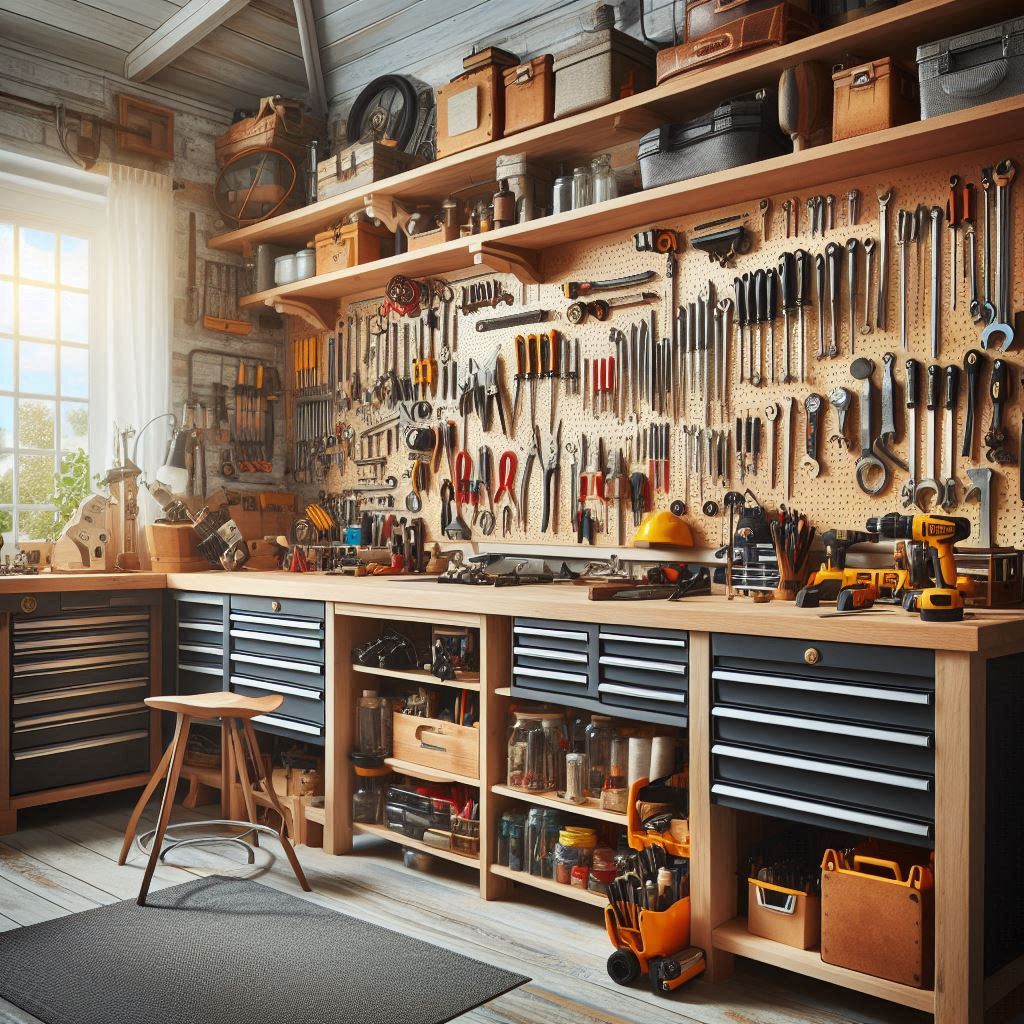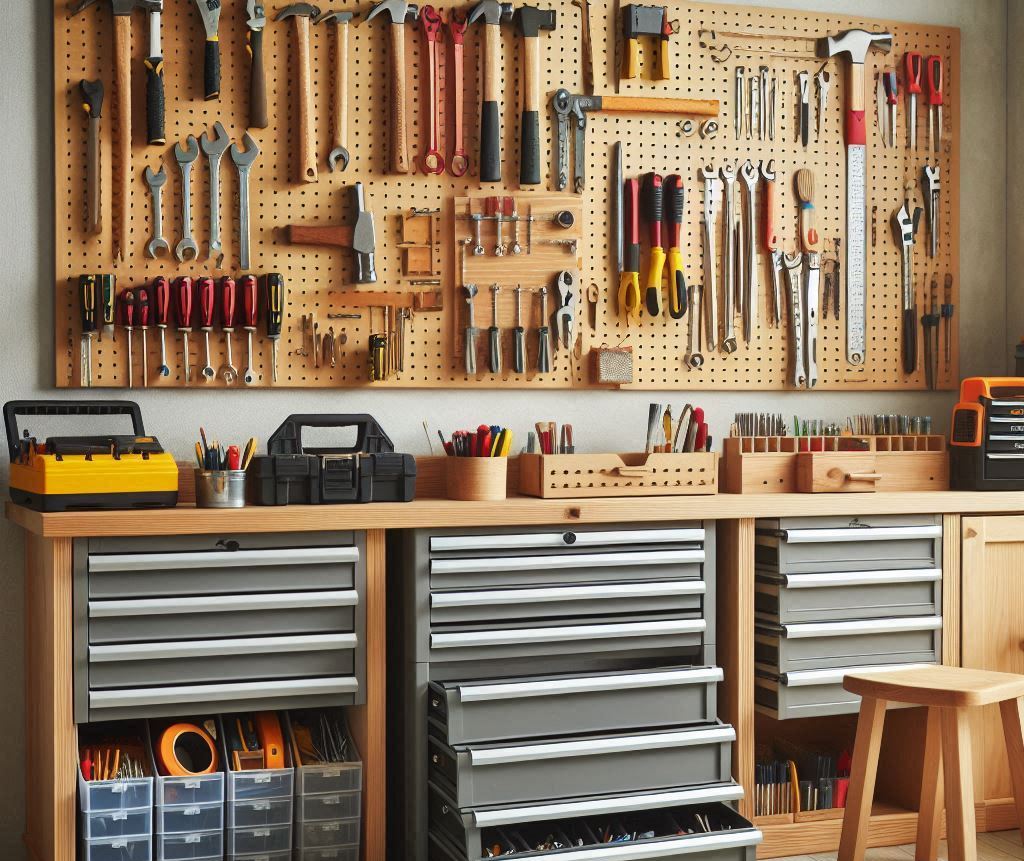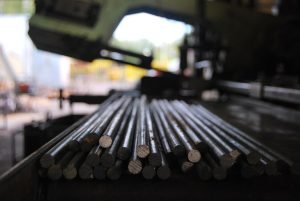Last Updated on February 26, 2025 by teamobn
A well-organized garage can make a world of difference when it comes to finding your tools, maintaining your equipment, and ensuring everything is stored safely. Whether you’re a weekend DIY enthusiast or a professional who brings work home, storing your tools and equipment properly is essential for safety and efficiency. Cluttered garages not only create stress, but they can also become hazardous environments if heavy tools or sharp objects aren’t stored correctly.
One way to begin organizing your garage is by using a site tool box to securely store essential tools that you frequently use. Beyond this, there are several strategies and storage solutions that will help you keep your tools and equipment safe, accessible, and well-maintained. Let’s explore how to store your tools safely in your garage while maximizing space and ease of use.
Contents
- 1 1. Assess Your Space and Tools
- 2 2. Use Pegboards for Smaller Tools
- 3 3. Store Larger Tools in a Secure Tool Chest or Site Tool Box
- 4 4. Maximize Vertical Space with Shelving
- 5 5. Hang Tools from Hooks and Racks
- 6 6. Keep Hazardous Materials Safely Contained
- 7 7. Utilize Overhead Storage for Seasonal Equipment
- 8 8. Keep Your Workspace Safe and Organized
- 9 9. Label and Inventory Your Tools
1. Assess Your Space and Tools
Before you start organizing, it’s important to assess both the space available in your garage and the types of tools and equipment you need to store. Take a moment to group your tools based on their size, frequency of use, and safety requirements.
- Sort by Use: Separate tools and equipment you use regularly from items that are only used occasionally. This will help you decide what needs to be more accessible and what can be stored higher up or in less accessible areas.
- Evaluate Your Space: Measure your garage space, including vertical height, to plan for storage solutions like shelves or pegboards. Don’t forget to factor in space for your vehicle or other large items that may be stored in the garage.
2. Use Pegboards for Smaller Tools
Pegboards are a simple but effective solution for organizing smaller hand tools like screwdrivers, wrenches, hammers, and pliers. They provide easy access while keeping your workspace organized.
- Install a Pegboard: Mount a pegboard on one of your garage walls and use a variety of hooks, bins, and baskets to hang tools. This allows you to customize the layout based on your needs.
- Label Your Tool Layout: Once you’ve organized your tools on the pegboard, consider labeling where each tool goes. This makes it easy to maintain order and ensures every tool has a designated spot.
3. Store Larger Tools in a Secure Tool Chest or Site Tool Box
For larger tools or power equipment, you’ll want to ensure they are stored in a way that keeps them protected and organized. A site tool box is a great option for securing valuable tools and ensuring they are safe from damage, theft, or misuse.
- Choose a Sturdy Tool Box: Select a heavy-duty tool box or chest that provides ample space for larger tools like drills, saws, or grinders. Make sure the tool box has locks to keep your equipment secure.
- Group Tools by Type: Organize the contents of your tool box by grouping similar items together. For example, keep all your power tools in one compartment and hand tools in another. This makes finding the right tool easier and faster.
4. Maximize Vertical Space with Shelving
Garage floor space is often at a premium, especially if you need to park a vehicle inside. Maximize vertical space by installing wall-mounted shelves that can hold tools, equipment, and other items you need to store.
- Use Heavy-Duty Shelving: Invest in sturdy, heavy-duty shelves that can support the weight of your tools and equipment. Opt for adjustable shelving units that can accommodate various sizes of items as your needs evolve.
- Categorize by Use or Season: Store items you use frequently on lower shelves for easy access, while placing seasonal or rarely used items on higher shelves. This helps keep the garage organized and clutter-free.
5. Hang Tools from Hooks and Racks

For bulkier items like ladders, garden tools, or extension cords, using hooks and racks can help keep your garage floor clear while providing easy access to your equipment.
- Install Wall Hooks for Bulky Tools: Wall-mounted hooks are ideal for hanging items like shovels, rakes, and ladders. Make sure the hooks are properly anchored to the wall to support the weight of heavier tools.
- Use Racks for Long Items: Racks can be mounted to hold longer tools such as brooms, mops, or hoses. These items can be stored vertically to save space and keep them organized.
6. Keep Hazardous Materials Safely Contained
If you store hazardous materials like paints, solvents, or cleaning chemicals in your garage, it’s crucial to keep them stored safely to avoid accidents or spills.
- Use Lockable Cabinets: Store hazardous materials in lockable cabinets or metal containers to prevent access by children or pets. Make sure the cabinet is well-ventilated and located away from direct sunlight or heat sources.
- Label Containers: Clearly label all containers and ensure they are tightly sealed to prevent leaks. If possible, store flammable items in a fireproof cabinet to reduce the risk of accidents.
7. Utilize Overhead Storage for Seasonal Equipment
For items that you don’t need access to year-round, such as seasonal sports equipment or camping gear, overhead storage can be a great solution. Overhead racks or ceiling-mounted storage units allow you to use otherwise wasted space in your garage.
- Install Ceiling-Mounted Racks: Use ceiling-mounted racks or storage lifts to store large, lightweight items like bicycles, kayaks, or holiday decorations. Be sure to follow the manufacturer’s guidelines for weight limits and installation.
- Use Clear Bins: Store items in clear, labeled bins to make it easier to identify what’s inside when the time comes to retrieve seasonal gear.
8. Keep Your Workspace Safe and Organized
In addition to storing tools and equipment securely, it’s important to maintain a clean and organized workspace. Regularly cleaning and organizing your garage will not only keep tools safe but also reduce the risk of accidents.
- Clean Up Regularly: After each project, take a few minutes to put tools back in their designated spots. This prevents clutter from building up and keeps your workspace clear.
- Sweep and Maintain the Floor: Keep your garage floor clean by sweeping up debris, dust, and any potential hazards. Consider using rubber mats or floor coverings to protect the concrete and reduce slipping hazards.
9. Label and Inventory Your Tools
To ensure that you always know where your tools are, consider creating an inventory system. Labeling tools, toolboxes, and storage areas can help you quickly find what you need and keep track of any missing items.
- Use Label Makers: Label drawers, shelves, and toolboxes to identify their contents easily. This will also help when it’s time to return items after use.
- Maintain a Tool Inventory: Keep a digital or written inventory of your tools and equipment. This can be useful in case of theft or loss, and it helps ensure you have all the tools you need for your projects.
By using these smart storage solutions, you can transform your garage into a safe, organized, and efficient workspace. Whether you’re utilizing a site tool box for secure storage, installing shelving for larger equipment, or using hooks and racks for bulky items, the key is to create a system that maximizes space while keeping your tools protected. Properly storing your tools and equipment not only extends their lifespan but also ensures that your garage remains a functional and safe space for all your projects.






